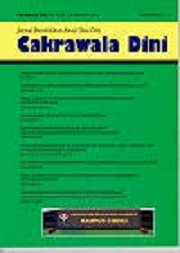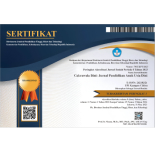Application of Indigenous Traditional Songs ‘Sewang’ in Preschool Teaching and Learning
Abstract
This study aims to examine the application of traditional Orang Asli songs in teaching and learning in preschool education. Traditional songs of the Orang Asli community have significant educational potential in fostering language development, cultural appreciation, and socio-emotional growth among preschool children. Using a qualitative approach, this research uses semi-structured interviews with preschool teachers. This study also uses document analysis of selected traditional songs to support the interview findings. Findings obtained from interviews with preschool teachers show that the application of traditional Orang Asli songs in the classroom has the potential to improve phonological awareness, vocabulary acquisition, and motor skills through group singing and movement activities. Document analysis of the repetitive lyrics and simple melodies of these traditional songs, themed around nature, community, and moral values, contributes to the preservation of the cultural heritage of the Orang Asli community. The implications of this study show that the application of traditional songs in teaching can strengthen children's language, as well as ensure the sustainability of indigenous culture in early education. This study highlights the use and application of traditional Orang Asli songs in enhancing language development, cultural appreciation, and socio-emotional growth of preschool children, which can then contribute to the preservation of the cultural heritage of the Orang Asli community.
Keywords
Full Text:
PDFReferences
Abd Ghani, A. (2015). The teaching of indigenous Orang Asli language in Peninsular Malaysia. Procedia-Social and Behavioral Sciences, 208, 253-262. https://doi.org/10.1016/j.sbspro.2015.11.201
Amalia, E. R., and Hasana, H. (2019). Improving the early childhood language skills through singing activity. Aulada: Jurnal Pendidikan dan Perkembangan Anak, 1(2), 1-12. https://e-journal.uac.ac.id/index.php/aulada/article/view/242
Bennett, C. (2022). Teaching culturally diverse choral music with intention and care: A review of literature. Update: Applications of Research in Music Education, 40(3), 60-70. https://doi.org/10.1177/87551233211051946
Blasco-Magraner, J. S., Bernabe-Valero, G., Marín-Liébana, P., and Moret-Tatay, C. (2021). Effects of the educational use of music on 3-to 12-year-old children’s emotional development: A systematic review. International Journal of Environmental Research and Public Health, 18(7), 3668. https://doi.org/10.3390/ijerph18073668
Bond, V. L. (2017). Culturally responsive education in music education: A literature review. Contributions to Music Education, 42, 153-180. https://www.jstor.org/stable/26367441
Britto, P. R., Lye, S. J., Proulx, K., Yousafzai, A. K., Matthews, S. G., Vaivada, T., Perez-Escamilla, R., Rao, N., lp, P., Fernald, L. C. H., MacMillan, H., Hanson, M., Wachs, T. D., Yao, H., Yoshikawa, H., Cerezo, A., Leckman, J. F., and Bhutta, Z. A. (2017). Nurturing care: Promoting early childhood development. The lancet, 389(10064), 91-102. https://www.thelancet.com/journals/lancet/article/PIIS0140-6736(16)31390-3/abstract
Carroll, D. (2017). Children’s invented notations: Extending knowledge of their intuitive musical understandings using a Vygotskian social constructivist view. Psychology of Music, 46(4), 521-539. https://doi.org/10.1177/0305735617716532
Chan, C. S. C. (2023). Demystifying knowledge on music transmission, creation, and succession among the indigenous Semai of Malaysia. Malaysian Journal of Music, 12(1), 80-98. https://doi.org/10.37134//mjm.vol12.1.6.2023
Dumont, E., Syurina, E. V., Feron, F. J., and van Hooren, S. (2017). Music interventions and child development: A critical review and further directions. Frontiers in Psychology, 8, 1-20. https://doi.org/10.3389/fpsyg.2017.01694
Fiveash, A., Bedoin, N., Gordon, R. L., and Tillmann, B. (2021). Processing rhythm in speech and music: Shared mechanisms and implications for developmental speech and language disorders. Neuropsychology, 35(8), 771-791. https://psycnet.apa.org/doi/10.1037/neu0000766
Gordon, R. L., Fehd, H. M., and McCandliss, B. D. (2015). Does music training enhance literacy skills? A meta-analysis. Frontiers in psychology, 6, 1-16. https://doi.org/10.3389/fpsyg.2015.01777
Gunawan, W. B. (2025). Revisiting the sustainable development goal 4 “Quality Education”: Insights, prospects, and recommendations. SAKAGURU: Journal of Pedagogy and Creative Teacher, 2(1), 12-36. https://doi.org/10.70211/sakaguru.v2i1.202
Hidayah, N., and Furnamasari, Y. F. (2025). Expression of children's drawings with creative methods using animated video media. Cakrawala Dini: Jurnal Pendidikan Anak Usia Dini, 16(1), 85-96. https://ejournal.upi.edu/index.php/cakrawaladini/article/view/83999
Idris, M. O., Mustafa, M. C., Wong, K. T., Hunpegan, H. D., and Ismail, A. O. (2024). Systematic review of reading proficiency among preschool pupils using PRISMA. Asian Journal of Assessment in Teaching and Learning, 14(2), 59-74. https://doi.org/10.37134/ajatel.vol14.2.5.2024
Idrus, F., Hussin, M. E., and Gulca, M. (2023). The integration of cultural elements in the English language classrooms: A case study of selected Orang Asli schools in Pahang, Malaysia. Journal of Nusantara Studies (JONUS), 8(1), 26-45. https://doi.org/10.24200/jonus.vol8iss1pp26-45
Ishak, S. A., and Aziz, A. A. (2022). Role play to improve ESL learners’ communication skills: A systematic review. International Journal of Academic Research in Business and Social Sciences, 12(10), 884-892. http://dx.doi.org/10.6007/IJARBSS/v12-i10/14851
Jeti, L., and Yusuf, O. Y. H. (2018). Stimulation of social emotional development in early childhood education. International Journal of Education, Information Technology, and Others, 1(1), 86-106. https://doi.org/10.5281/zenodo.1422779
Karjalainen, H. (2020). Cultural identity and its impact on today’s multicultural organizations. International Journal of Cross Cultural Management, 20(2), 249-262. https://doi.org/10.1177/1470595820944207
Masnan, S. B. A., and Mohamed, S. (2023). Tahap pengetahuan dan kemahiran guru dalam melaksanakan aktiviti muzik dan pergerakan terhadap kanak-kanak prasekolah. Malaysian Journal of Social Sciences and Humanities (MJSSH), 8(3), e002194. https://doi.org/10.47405/mjssh.v8i3.2194
Nurfitriana, D., Pamungkas, J., and Hayati, N. (2025). Utilization of local Jogja cultural videos to increase tolerance in early childhood: Literature review. Cakrawala Dini: Jurnal Pendidikan Anak Usia Dini, 16(1), 63-70. https://ejournal.upi.edu/index.php/cakrawaladini/article/view/82966
Politimou, N., Bella, S. D., Farrugia, N., and Franco, F. (2019). Born to speak and sing: Musical predictors of language development in pre-schoolers. Frontiers in Psychology, 10, 948. https://doi.org/10.3389/fpsyg.2019.00948
Salim, M. S. A. M., Adnan, A. H. M., Shah, D. S. M., Tahir, M. H. M., and Yusof, A. M. (2020). The Orang Asli in Malaysian formal education: Orang Asli teachers’sentiments and observations. International Journal of Humanities Technology and Civilization, 5(1), 57-64. https://doi.org/10.15282/ijhtc.v5i1.4819
Sawalludin, A. F., Min, C. L. J., and Ishar, M. I. M. (2020). The struggle of Orang Asli in education: Quality of education. Malaysian Journal of Social Sciences and Humanities (MJSSH), 5(1), 46-51. https://doi.org/10.47405/mjssh.v5i1.346
Shaw, A. (2021). Read, speak, sing: Promoting early literacy in the health care setting. Paediatrics & Child Health, 26(3), 182-188. https://doi.org/10.1093/pch/pxab005
Váradi, J. (2022). A review of the literature on the relationship of music education to the development of socio-emotional learning. Sage Open, 12(1), 1-11. https://doi.org/10.1177/21582440211068501
Zhou, W., Guo, K., Ying, Y., and Oubibi, M. (2024). Chinese local music teaching materials: A review from 1934 to 2022. Social Sciences & Humanities Open, 9, 100742. https://doi.org/10.1016/j.ssaho.2023.100742
DOI: https://doi.org/10.17509/cd.v16i2.82450
Refbacks
- There are currently no refbacks.
Copyright (c) 2025 UPI Kampus Cibiru

This work is licensed under a Creative Commons Attribution-ShareAlike 4.0 International License.
Cakrawala Dini: Jurnal Pendidikan Anak Usia Dini
Published in collaboration Program Studi PGPAUD UPI Kampus Cibiru, APG PAUD Indonesia, and PPJ PAUD Indonesia

Cakrawala Dini: Jurnal Pendidikan Anak Usia Dini is licensed under a Creative Commons Attribution-ShareAlike 4.0 International License.
Based on a work at https://ejournal.upi.edu/index.php/cakrawaladini.














